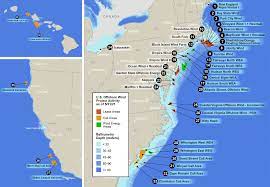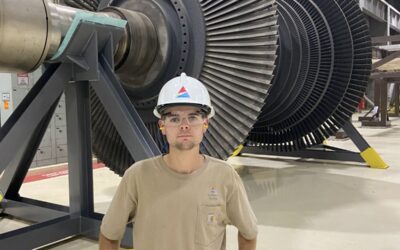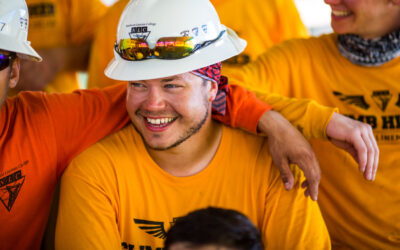Europe has been developing offshore wind farms for decades, but in the United States today this industry is starting to grow exponentially. The 30 MW Block Island Wind Farm – the first offshore wind farm in the U.S. – was completed in 2016, and the 12 MW Coastal Virginia Offshore Wind project test facility – the first utility-owned offshore wind farm in the country and the beginning of a 2.6 GW project – was completed in 2020. Generated offshore wind energy is set to grow in leaps and bounds as more projects are developed and completed. According to the National Renewable Energy Laboratory (NREL), in 2020 the U.S. offshore wind energy project development and operational pipeline experienced a 24% increase in potential generating capacity from 2019, totaling over 35 GW.

Supporting the growth of the offshore wind industry are the ambitious state and national goals set forth across government. These goals envision a clean energy future powered by offshore wind and are setting targets to help get us there. The Biden Administration’s national offshore wind target of 30 GW of offshore wind energy by 2030 also works to catalyze the industry, strengthen the domestic supply chain, and support job creation.
Locations of U.S. offshore wind pipeline activity and Call Areas as of May 31, 2021. [U.S. DOE, 2021]
What Types of Careers Are Available in Offshore Wind?
Offshore wind is similar to the wind energy that is captured on land in many ways, with some key differences. You may have driven past wind farms on land before, but now imagine a turbine almost twice as tall out in the ocean; these are not your great-grandfather’s windmills! Windmills turn blades, converting wind energy into mechanical energy to mill and grind crops; today’s modern wind turbines don’t mill anything, but rather convert wind into electricity. The larger the turbine and blades, the more electricity that can be produced, meaning larger offshore wind turbines are able to generate more power.
The Massachusetts Clean Energy Center has identified 119 different occupations across offshore wind project development. Here’s a look at just some of the career opportunities available:
| Offshore Wind Development Phase | Examples of Occupations Available |
|---|---|
| Planning and Development | Engineers, Financial Analysts, and Lawyers |
| Manufacturing and Assembly | Engineers, Metal Workers, Assemblers, and Administrative Staff |
| Construction and Installation | Crane Operators, Electricians, Line Workers, and Welders |
| Operations and Maintenance | Administrative Staff, Wind Turbine Technicians, Marine Operators, and Plant Managers |
| Support Services (e.g., transportation, training, research, consulting) | Meteorologists, Vessel Mechanics, Lawyers, and Policy Experts |
There are also indirect workforce opportunities, meaning other occupations within the offshore wind supply chain. These include careers with utilities or original equipment manufacturers who produce blades, towers, or nacelles, and are a critical part of the offshore wind supply chain.
What Are the Opportunities for Offshore Wind Research and Development?
There are opportunities to support the offshore wind industry in academic and research institutions, government, nonprofit, and other nongovernmental organizations. If you’re interested in a career in academia and research, you may be interested in attending the National Offshore Wind Research and Development Consortium (NOWRDC) Technical R&D Symposium. More information on the free and virtual symposium here.
In addition, NOWRDC works to accelerate the U.S. offshore wind industry in support of U.S. energy policy. This nationally focused, not-for-profit organization collaborates with industry on prioritized research and development (R&D) activities to reduce the levelized cost of energy of offshore wind in the U.S., while also maximizing other economic and social benefits, including the supply chain.
Joining the Offshore Wind Industry
There are opportunities to join the offshore wind workforce no matter your background. There are education and exposure opportunities for middle- and high-school-aged students (e.g., NYSERDA’s Offshore Wind Youth Action Program), programs and certificates for undergraduate and graduate students (e.g., at the University of Massachusetts Amherst, Tufts University, and University of Delaware), and professional programs for those interested in how their current skills could be transitioned to the offshore wind industry (e.g., at the University of Delaware, Stony Brook University, SUNY Farmingdale State College, or Massachusetts Maritime Academy).
The offshore wind industry is moving fast, and while embarking on a degree or professional program is a fantastic way to prepare yourself to enter the industry, there’s also a clear need for a skilled and experienced workforce now. Incumbent worker trainings focus on reskilling trade, construction, and maritime workers who, with additional safety or technical training and/or certifications, can be well prepared to participate in the offshore wind industry. There are many skilled workers who could fall into this category, many of whom may currently work within the oil and gas industry.
There are many different ways to get involved in careers in offshore wind. The wind is at your back!
Article courtesy of Christine Sloan, National Offshore Wind Research and Development Consortium
Cover photo: Offshore wind substructure designs for varying water depths. Illustration by Josh Bauer, NREL




